Back to blog
12 MIN READ
App Onboarding Guide: Top 10 Onboarding Flow Examples 2025
PUBLISHED
9 July, 2025

Product Analytics Expert

First impressions matter - especially in apps where users decide within seconds whether to stay or leave. With over 90% of downloaded apps being abandoned within the first month, effective onboarding is essential for survival.
Best mobile app onboarding examples
The best apps create "aha moments" that immediately demonstrate value. Here's how 10 successful apps master this critical first interaction, and what you can learn from their approaches.
What Makes Great App Onboarding?
Effective onboarding answers five crucial questions within the first few screens:
What problem does this app solve for me?
How quickly can I start using it?
What value will I get immediately?
How simple is the setup process?
Why should I continue using this app?
The apps below excel at answering these questions while minimizing friction and maximizing early engagement.
LinkedIn User Onboarding Flow
The Strategy: LinkedIn breaks onboarding into digestible stages rather than overwhelming users with everything at once.
What They Do Well:
Clear value proposition: "Make the most of your professional life" immediately communicates purpose
Staged approach: Four distinct phases prevent cognitive overload
Personalized welcome: Uses your name and profile data to create connection
Immediate networking: Encourages valuable connections before exploring features
This app has a progressive onboarding flow where the app guides you into setting up your profile.
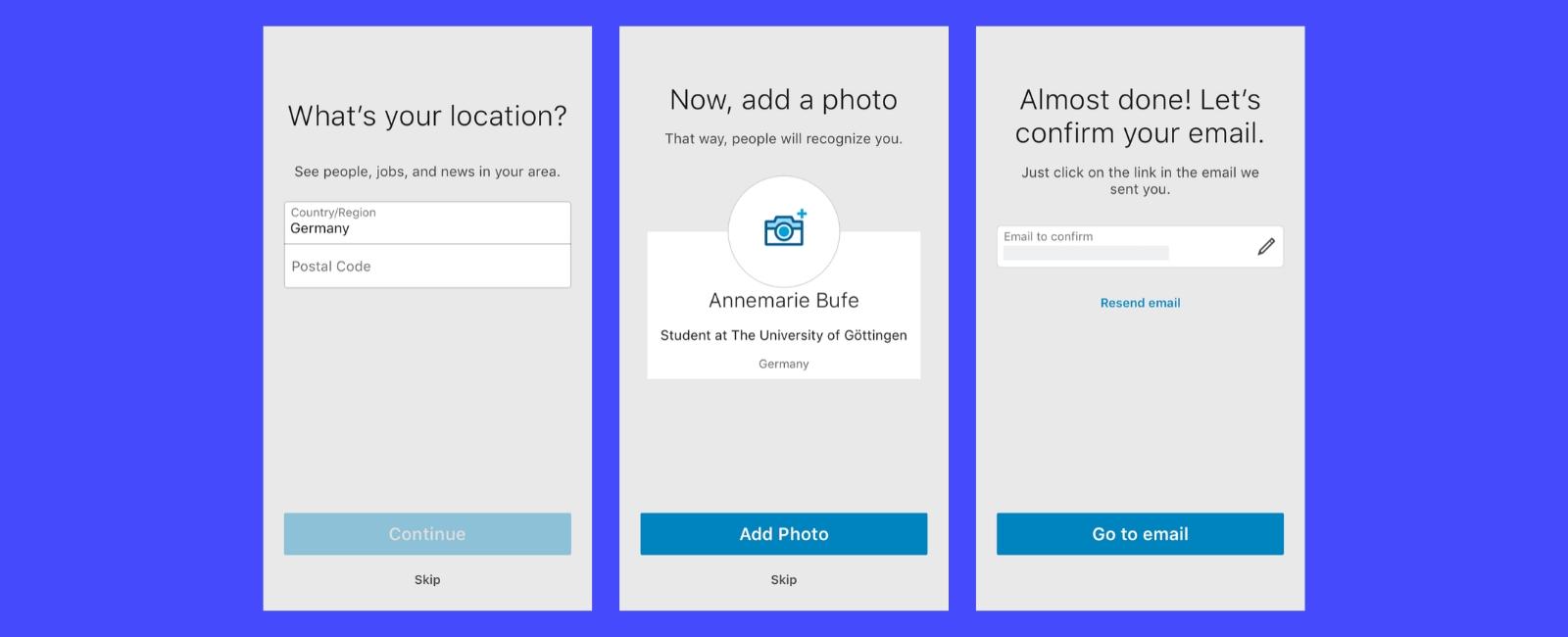

As you log in, LinkedIn welcomes you with a personalized message.
This divides the new user onboarding into 4 stages:
1. Complete your personal information.
2. Receive email confirmation.
3. Follow LinkedIn groups and thought leaders.
4. Get suggestions of people to add to your professional network.
Key Takeaway: Progressive onboarding works because it mirrors natural relationship building.
LinkedIn wants you to follow thought leaders and connect with people during onboarding - before you use the app.
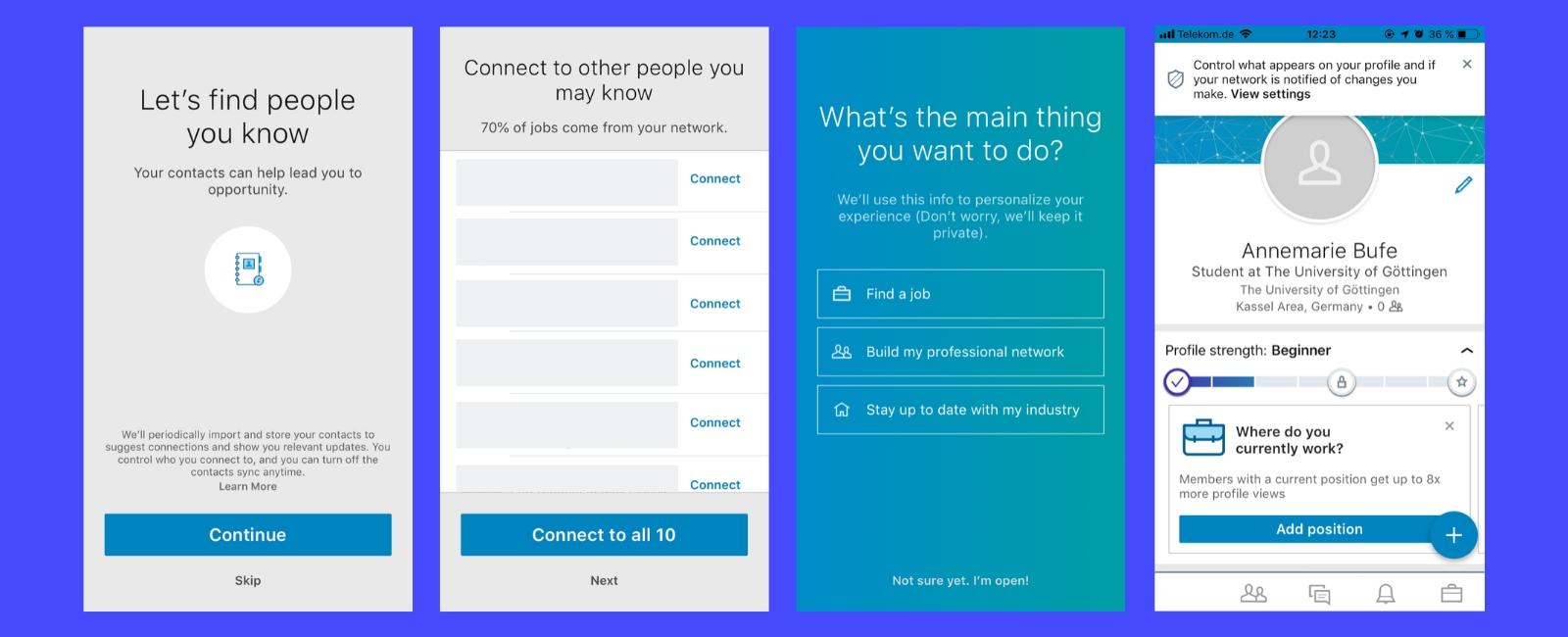

After you finish your profile setup, LinkedIn takes you to the main app page.
LinkedIn divides the main app page into two sections. First, a menu section with customizable tabs; then, a page feed with the message: “Nice! You are all set”, which brings a human touch to the app.
To monitor the effectiveness of your app's onboarding flow like LinkedIn, you can set up funnel analytics to track how users progress through the onboarding process and identify any areas where they may be dropping off.
Here's an example of an onboarding funnel in UXCam.
UXCam is a product analytics tool for mobile apps and websites. It uses AI to help you understand user behavior and monitor performance metrics.
Big brands like Costa Coffee and Virgin Mobile use it to optimize the onboarding experience and improve user retention.
Instagram App Onboarding Flow
The Strategy: Instagram uses existing social connections to create immediate engagement and fear of missing out.
What They Do Well:
Social integration: Facebook login pre-fills information and suggests friends
FOMO activation: Shows which friends already use the platform
Celebrity suggestions: Offers immediate high-value content to follow
Minimal friction: Two-step signup process
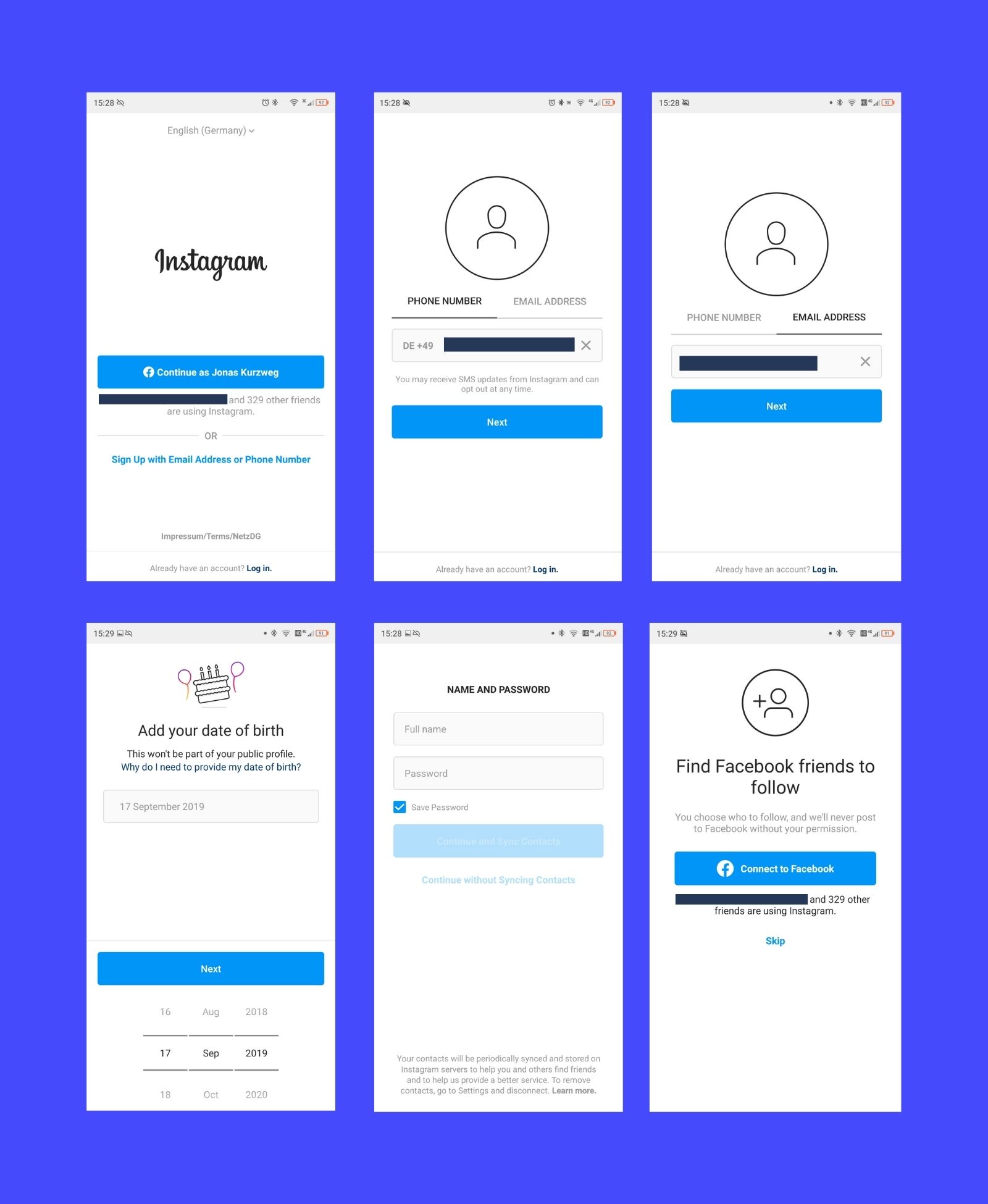

Meta uses the power of its social network to do the work for you and provide you with pre-filled form fields. It also suggests friends who already use Instagram. This creates FOMO: fear of missing out. FOMO serves as a motivation trigger to complete the onboarding flow.
Instagram gives you the option to follow celebrities and other public figures — chances are that these suggestions are based on your Facebook friends.
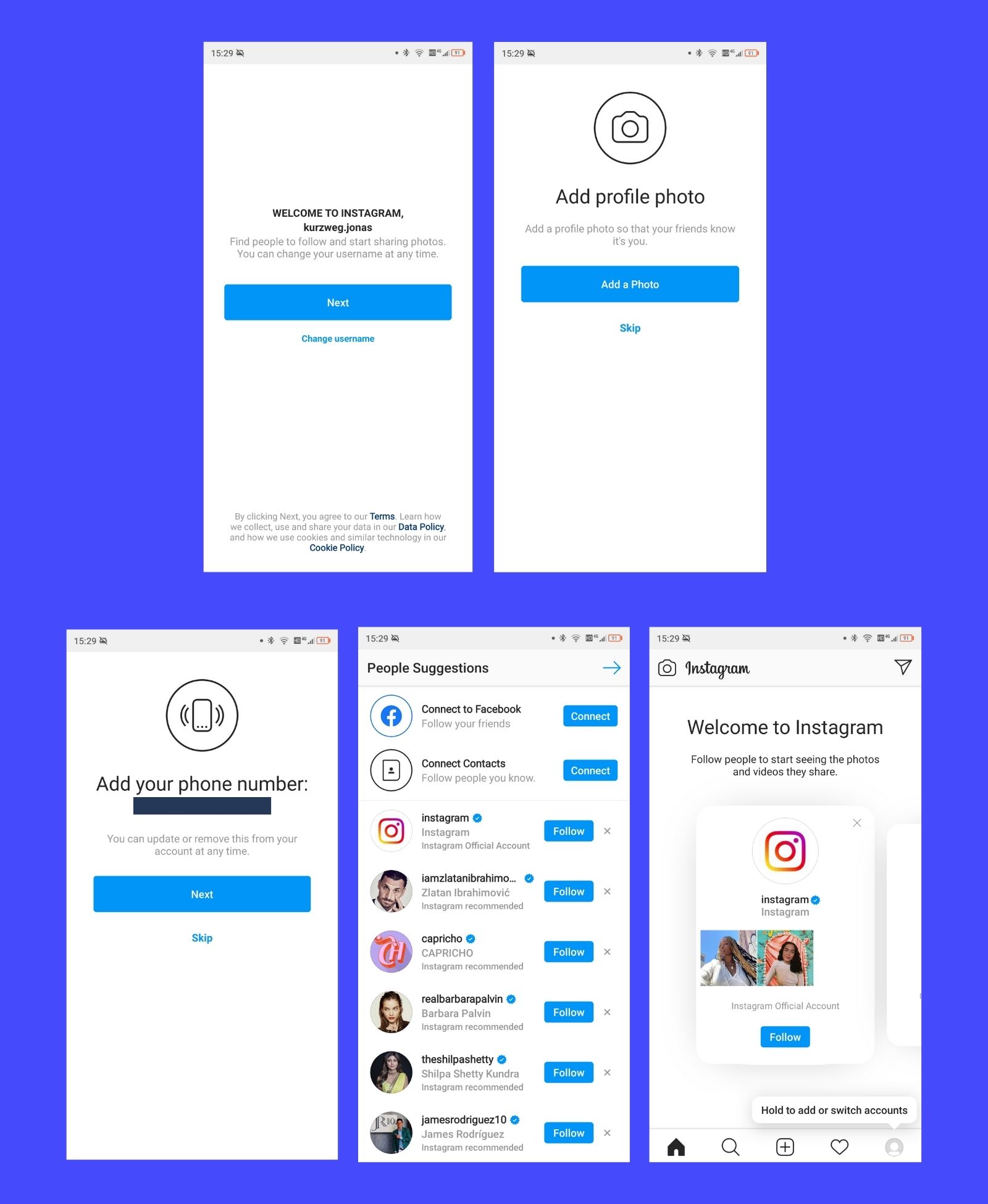

Key Takeaway: Instagram is a perfect example of how to create FOMO to push users to register.
To monitor the effectiveness of an onboarding process like Instagram's, session replays are a great tool. They allow you to watch video replays of user sessions to see how they interact with the app and identify any areas where they may be struggling or dropping off.
SoundCloud In-App Onboarding Flow
The Strategy: SoundCloud prioritizes immediate value discovery over lengthy explanations.
What They Do Well:
Multiple login options: Email, Facebook, Apple ID, or Google (with email de-emphasized due to higher friction)
Minimal explanation: No lengthy feature tours - the interface speaks for itself
Instant exploration: Users can immediately start discovering music
SoundCloud is a popular music social network app. It allows you to sign up using your email address, Facebook account, Apple ID, or Google ID.
Note that the email field is highlighted the least because it’s likely to have a lower conversion rate due to the increased friction.
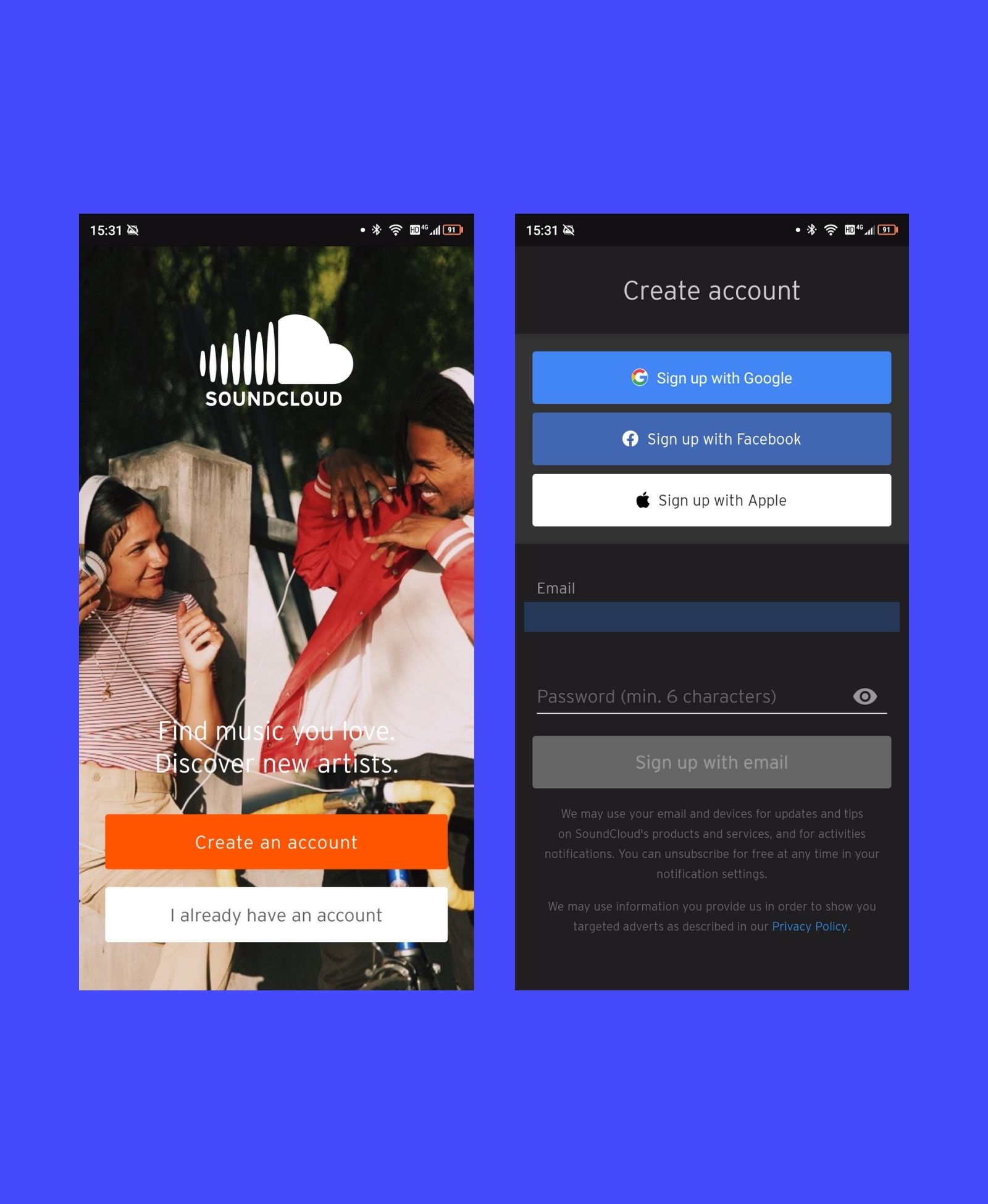

After its one-step sign-up process, SoundCloud asks you to continue by accepting the terms and conditions of the app.
Afterward, it asks you for your age and gender — possibly to gain a better understanding of audience demographics.
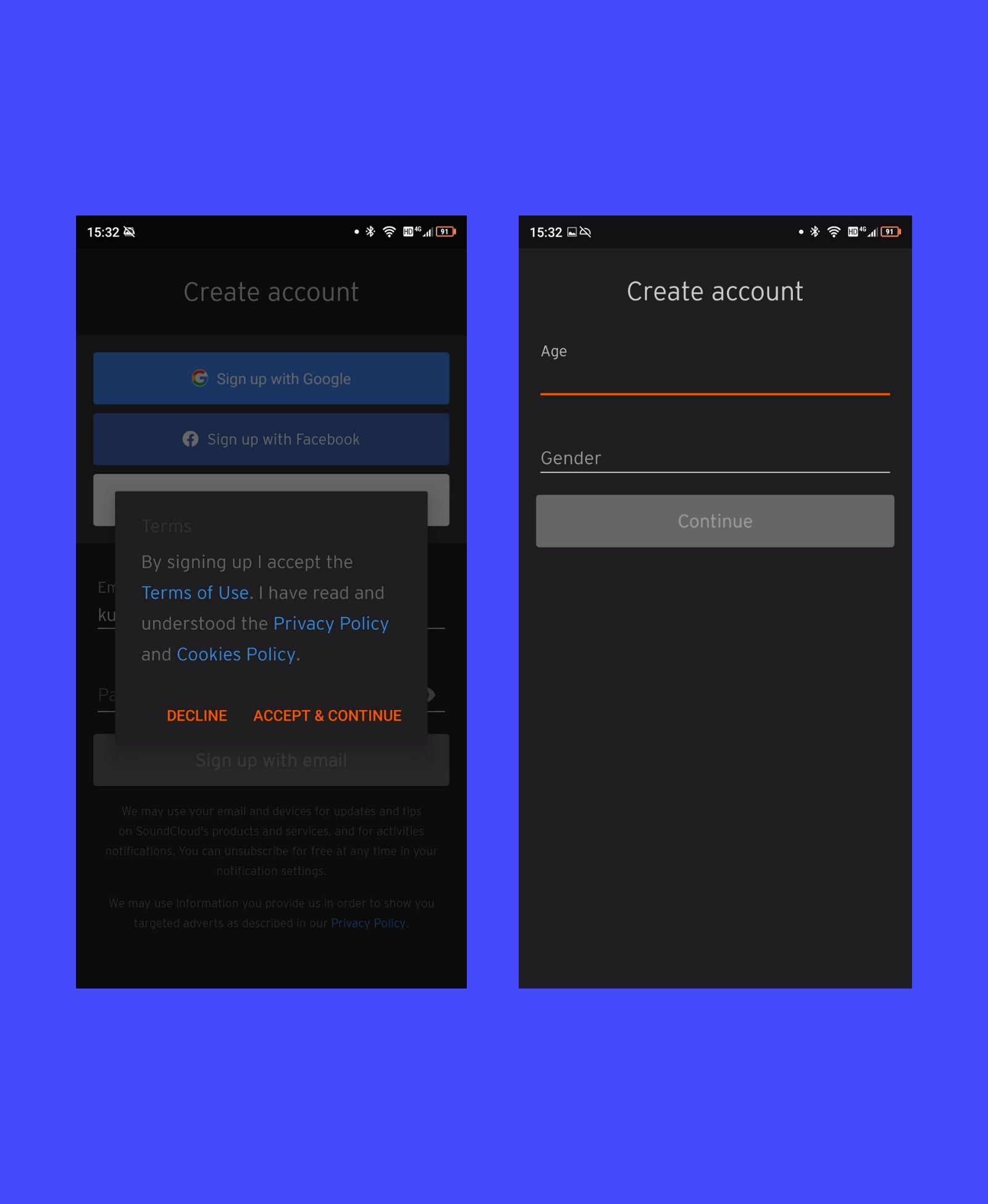

Next, the app asks for consent to track what you do within it. In turn, it offers you personalized ads. Then you are done and can enter the main page.
SoundCloud does not bother explaining the benefits or functionality of its app — instead, you can immediately start exploring music.
This is great onboarding because the UX is self-explanatory and SoundCloud gets users to the AHA-Moment as fast as possible.


The AHA-Moment occurs when the user experiences the value of an app for the first time. Get users to the aha moment as fast as possible!
On the main app page, you can follow music based on playlists. Given its minimalist user interface design, users with any background can explore the app to search for music, follow users, or stream their audio or podcast.
Soundcloud optimizes every single onboarding screen. When you optimize your screens, heatmaps can help you by showing you where users are spending the most time and where they are getting stuck.
For example, if you notice that users are spending a lot of time on a particular screen, you can use that information to refine the content or layout of that screen to make it more effective.
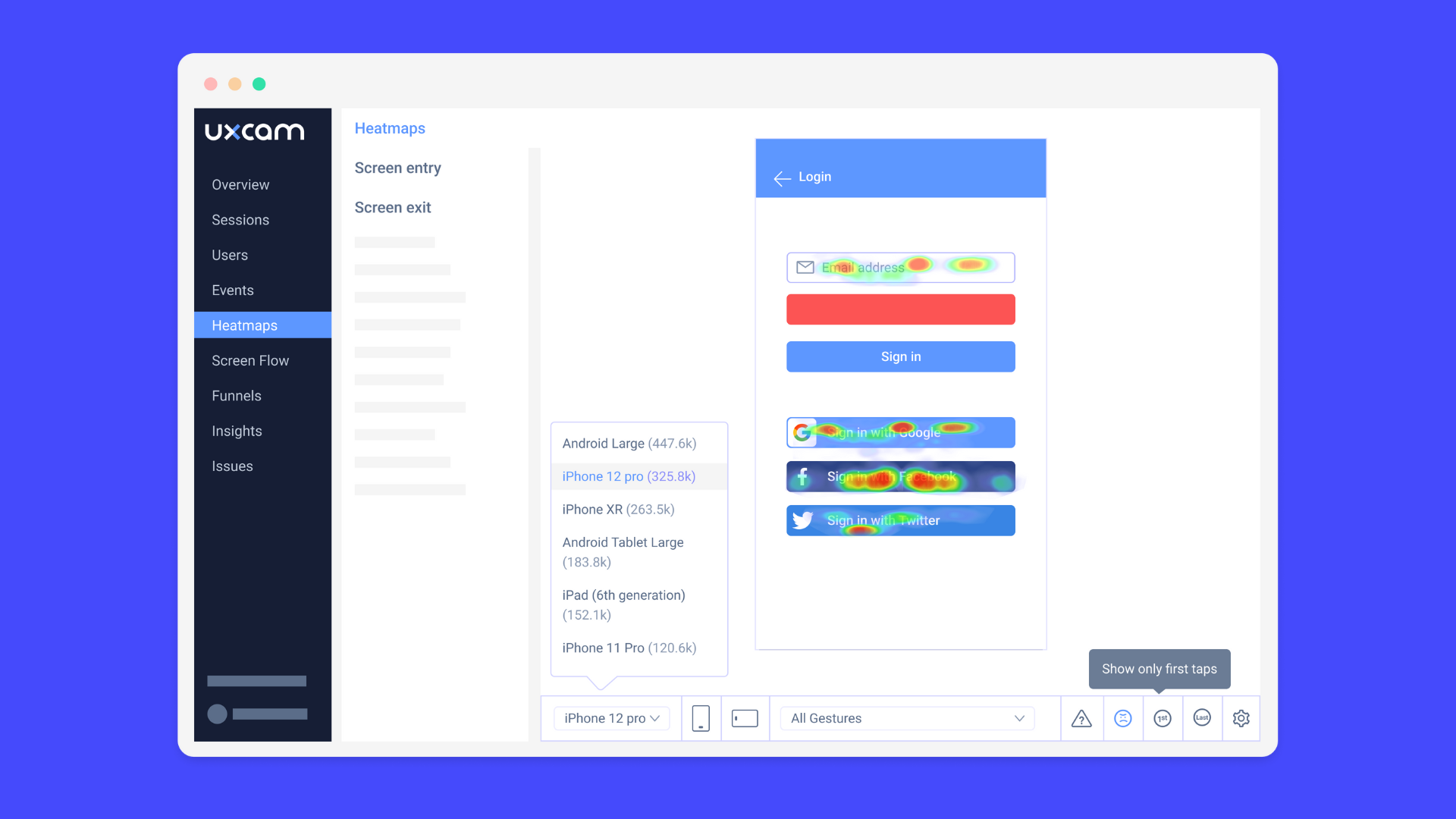

Alternatively, if you see that users are dropping off at a certain point in the onboarding flow, you can use heatmaps to identify the cause and make changes to improve the experience. You can use a platform like UXCam to analyze mobile app heatmaps.
Wise Mobile User Onboarding Flow
Wise enables you to transfer money abroad easily and quickly with their low-cost transfers. In a perfect example of "show don't tell", the Wise welcome screen enables visitors to check out their rates before logging in or signing up.
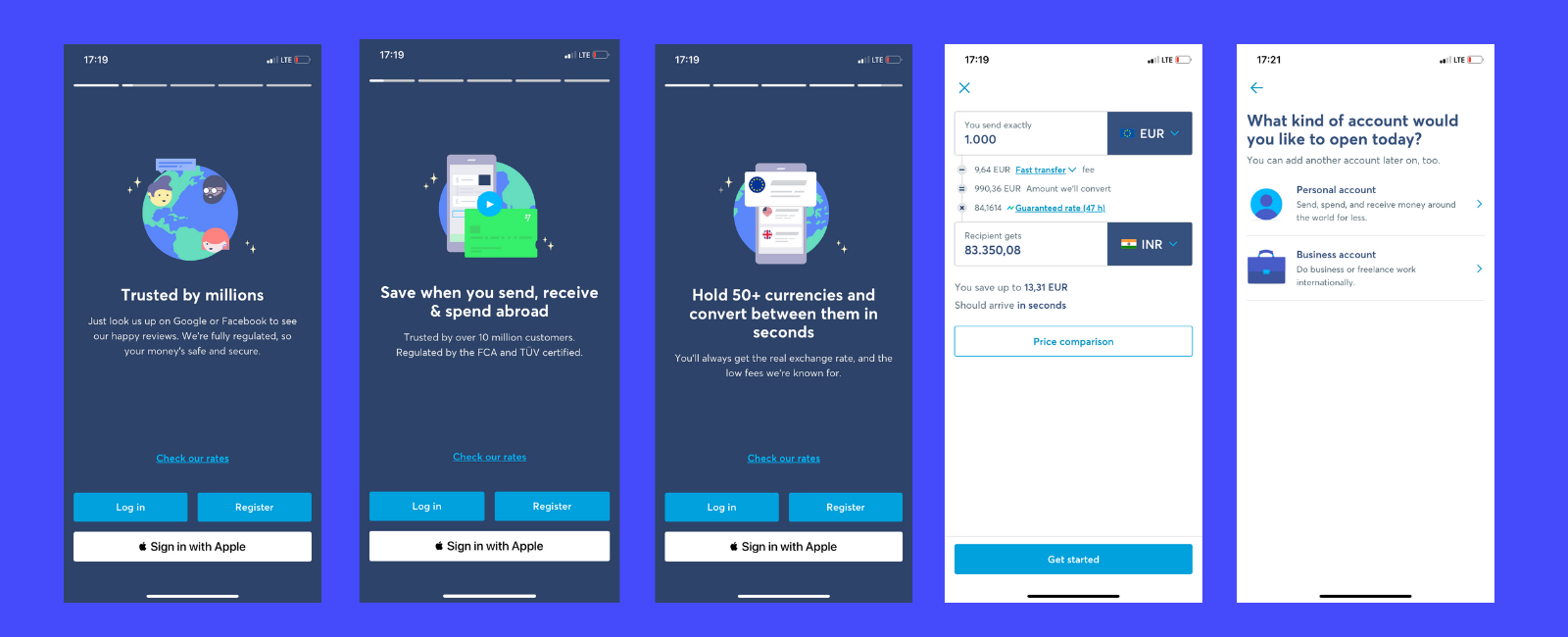

This new feature for non-logged-in users was only released in the past 6 months. The low rates that Wise offers are one of their main selling points, so it puts the value of their app front and center of the onboarding process.
If that doesn't convince you of the benefits of the app, they've got tons of welcome screens that remind you of exactly why you downloaded this app. Unlike PayPal, Wise also gives the option of choosing what type of account you'd like to open, business or personal.
Considering money transfers overseas are a common feature that small businesses need, they're speaking to their target audience.
To get an in-depth analysis of PayPal vs Wise, access our app analysis for free. See over 30 screenshots of the app experience of these financial apps.
MyFitnessPal App Onboarding Flow
MyFitnessPal is a calorie-counting and diet plan app to help you gain, maintain or lose weight. This app has a nice onboarding experience, particularly considering the number of features it has.
After letting you sign up with Facebook or email, the app guides you to set your weight goal.
Let’s say your goal is to gain weight. The app will ask you about your height, current weight, and desired weight so it knows how much you want to put on.
The only hiccup in user onboarding takes place when the app asks you to fill in your username and password, even though you already signed up using Facebook.
After you have set up your goal, MyFitnessPal has a step-by-step guide to get you acquainted with the functionalities of the app. You then fill in your daily diet and how much water you consume, and you’re all set to start tracking your fitness.
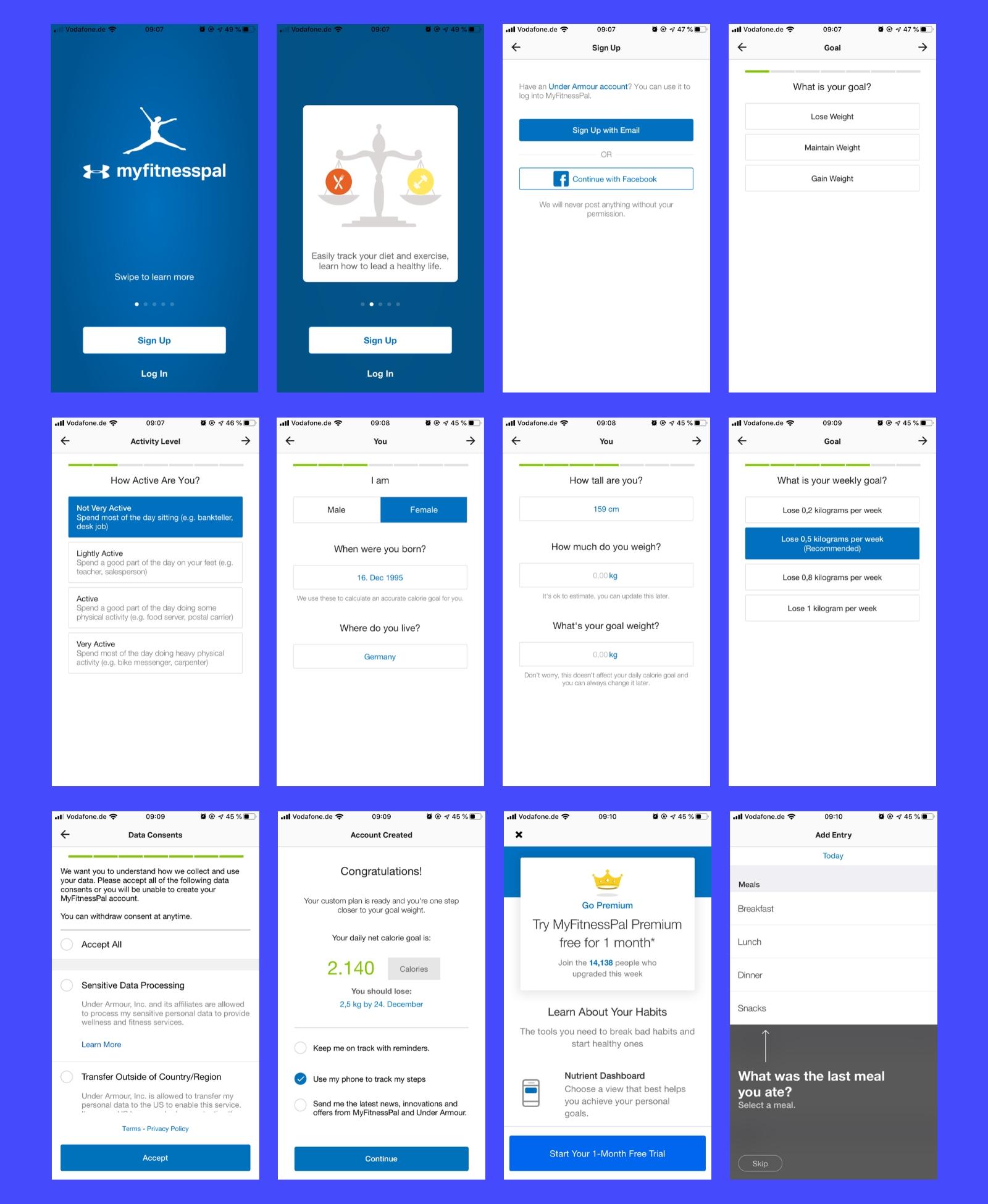

Typically, apps should be simple to use with little to no instruction. But what about when they offer more complicated features that you can’t pick up that easily?
Holding your user’s hand to show them around is a good approach. MyFitnessPal is a good example of using progressive onboarding combined with function-oriented onboarding.
Binance User Onboarding Flow
Binance - the cryptocurrency trading platform, makes it possible for users to view the play around with the app before completing KYC (know your customer).
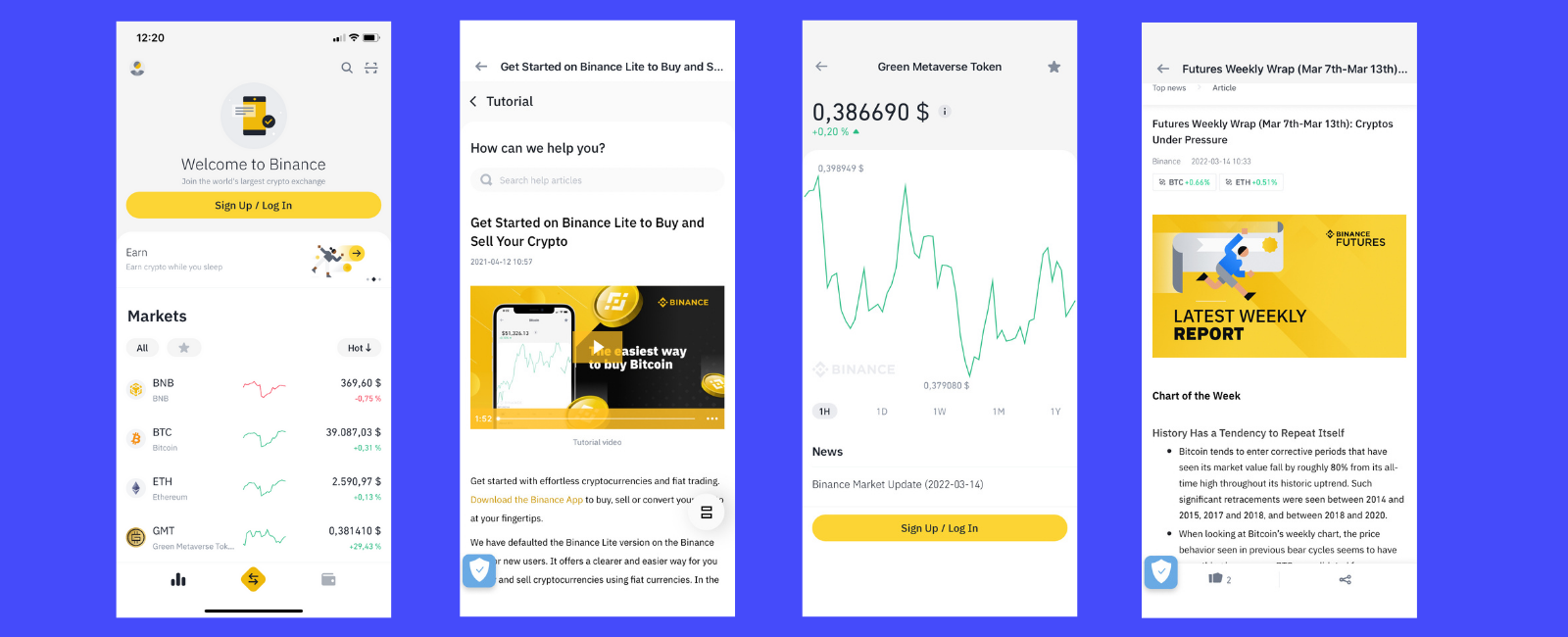

As many finance app fans will know, the KYC process is a bit of a pain: waiting in a virtual line, having your documents physically available, and of course, tilting your ID up and down till the shiny thing shows. So letting users check out the app before going through this process is considered their journey.
With just your phone number and email address, you can view the different markets, and check out different currencies, and the news associated with them.
Not to mention, users can also view videos on how to buy and sell on the app. The onboarding is designed for people who are both new to the app and the industry.
Strava App Onboarding Flow
Strava — a social networking site for athletes and cyclists — helps track your runs and rides through GPS. With over 55 million users, Strava is quick to onboard them.
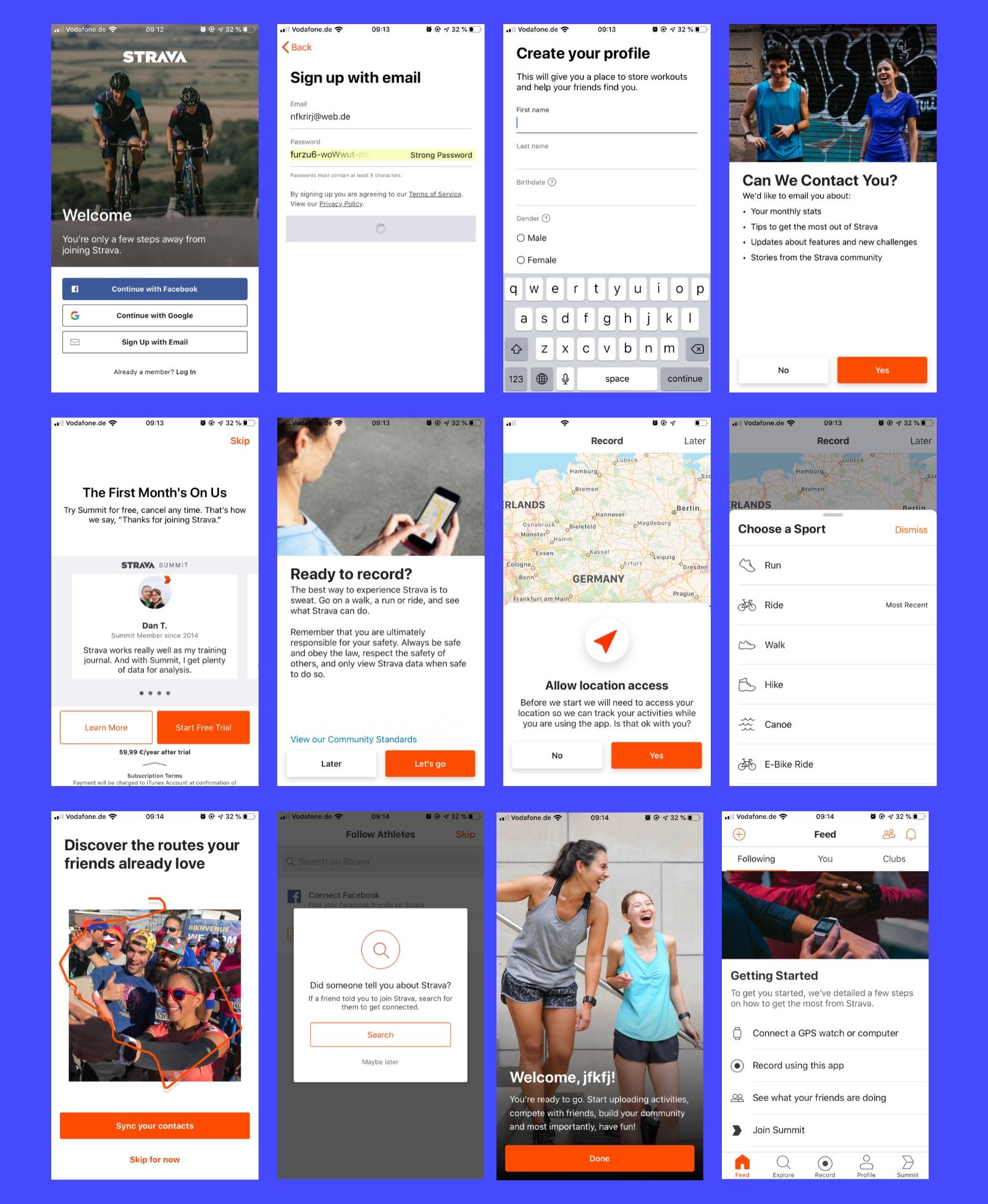

It allows users to sign up via Facebook, Google or email. When you sign up, it directs you to a page where you can import your Facebook contacts or search for users by name.
The next onboarding screen, after following people, directly asks you to begin to use the app. It encourages you to start an activity like running or riding, and after that, you are on your own to check out the rest of the functionalities.
Their approach is presenting you with an easy and relevant task with a tidy and simplistic UI.
Tinder Mobile Application Onboarding Flow
Tinder — a location-based dating and social discovery application — is another app with a great onboarding experience.
The app facilitates communication between mutually interested users. Once users have matched, they are offered the option to chat. It uses Facebook to sign you up, and then you’re all set.
With its simple use of UI, whenever you stumble upon an app feature for the first time the app explains it to you with a pop-up message.
Within seconds you will be using the app as if you had been on it for ages.
There's more to Tinder's onboarding, and you can read all about it in our free app analysis.
Expensify Mobile App Onboarding Flow
Expensify is an app that helps you track, manage, and report your expenses. This financial app has a user onboarding flow we can get behind.
Before signing up, the screen tries to communicate the benefits of the app to the prospects.
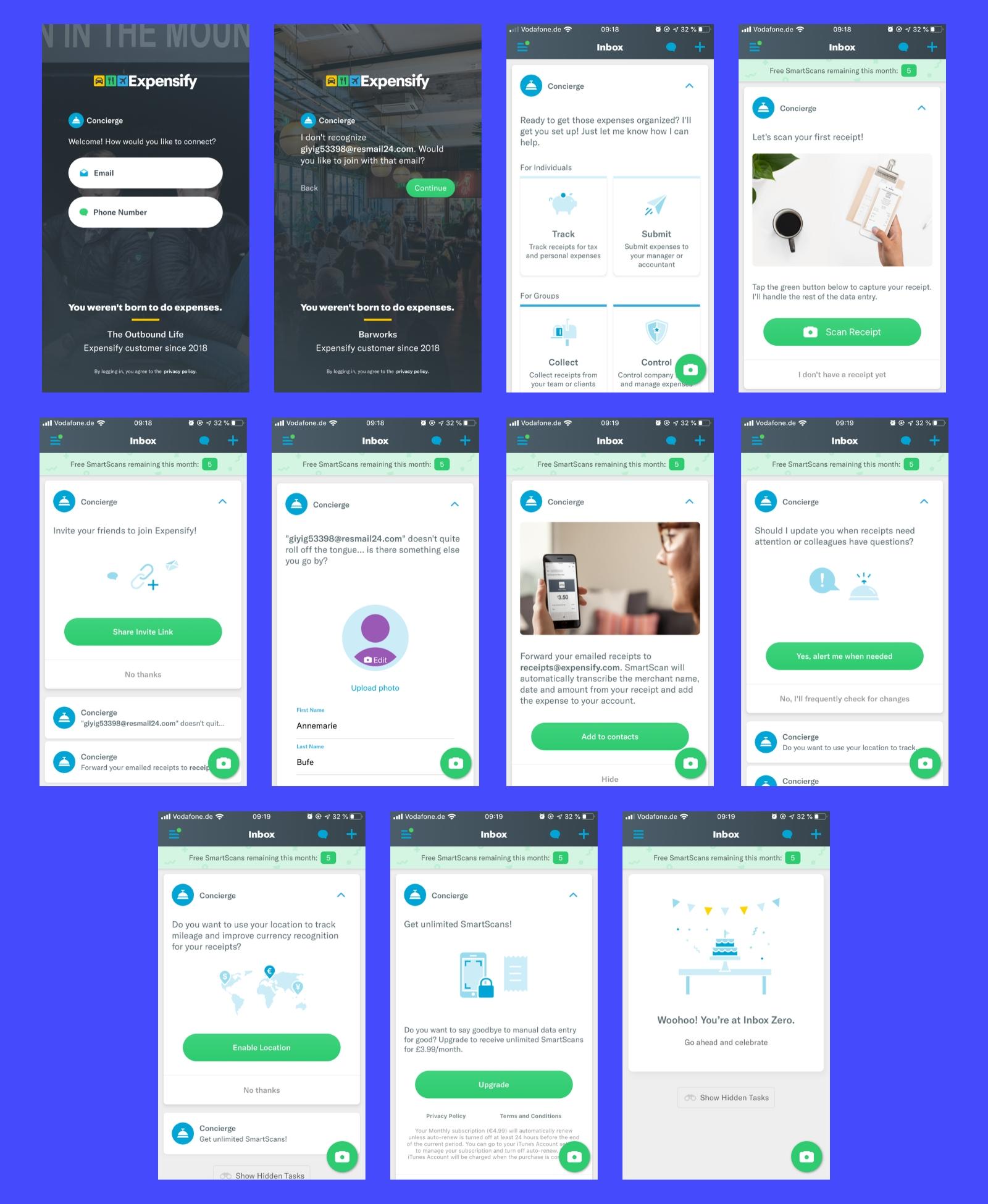

The signup process of Expensify is the simplest of any app.
Just provide your email address, and you can later set the password from an email that will be sent to you.
The app has a clear message and CTA, letting you know what to do. The first time that you use it, Expensify will guide you with pop-up messages.
The rest of the experience of using the app is self-explanatory. It also does not impose much on the app user on any given page but rather keeps it simple by only exploring one idea per page.
How can I improve my onboarding flow?
There are many ways to improve your onboarding flow, starting with monitoring it closely. You can use session, user, and funnel analysis that provides insights into the drop-offs during onboarding or any other part of the journey (e.g. search flow, browsing flow, checkout flow). Monitoring makes it easier to find and fix bottlenecks, know where and why users churn, and understand what actions get users where.
You can try UXCam's product analytics for free without a credit card to improve your onboarding flow. Use funnel analytics, heatmaps, and session recordings to see why users aren't making it through their onboarding journey.
How do I onboard customers onto my app?
1. Frontload the value. When users open the app, have a page that reminds them of why they downloaded it. Keep this short, sweet, and easy to read.
2. Collect essential information only. When setting up the sign-up / registration process, try to be as swift as possible if registration MUST be at the beginning of the app. The user will likely have to go in and out of the app for security protocols e.g., checking their email, SMS notification, push notification, or Whatsapp confirmation. At this stage, don't ask for too much like access to contacts or sending invitations.
3. Keep instructions simple and concise. If using welcome screens, try to make the steps easy like pay, click, and go. Keep the page as visual as possible and avoid lengthy text.
4. Request permission. Once the person is already onboarded onto the app and registered, you can begin to request permission to contact or other information necessary to use the app. e.g. if it is a scanning app, asking for access to the camera seems reasonable registration.
5. Make it easy to skip steps if the user doesn't have to register to view the benefits of the app. It's a positive user experience if someone wants to view the products on a shopping app before having to give up their personal information. Opening an app and being able to see the value immediately often leads to a positive experience.
What is app onboarding?
App onboarding is the process of introducing users to your mobile app, often with the goal of user retention and long-term engagement. It's the critical first impression that app users have with your product. Mobile app onboarding could be a combination of informative welcome pages, login/register, and any other educational screens about the benefit that will get a user onboarded onto the app. If it's well-designed and welcoming, they're likely to continue their journey with your app.
Why is mobile app onboarding important?
Mobile app onboarding is important because it puts the product's value in front and center. From the second users open your app, the onboarding should get them to their "aha, this is what I needed!" moment faster and drive app retention. The best app onboarding experiences usually answer questions like:
How can I start using this app?
How does this app work?
What are the benefits of this app?
How does this app solve my problem?
What data do I need to give to use this app?
Nowadays, users have to log in to use an app. This process should be as simple as possible while being friendly.
Is app onboarding necessary?
App onboarding creates a positive user experience and contributes to user retention, leading to app success. The best onboarding experience is engaging, and seamless, and keeps users interested in your app and coming back.
What is a mobile onboarding flow?
The onboarding flow is the sequence of steps that new or existing users take when they open your product. An example of a flow includes a welcome page, two informational splash screens, and a login and registration page. The mobile app onboarding flow can differ from the flow on a desktop.
Mobile app onboarding best practices
1. Track your onboarding funnels to see why users are dropping off of the app onboarding process. This is the first step of hypothesizing whether your onboarding flow is too challenging e.g. password creation is difficult.
2. User microcopy to guide users through the experience and to add personality to pages. If you've got a page that takes a few seconds longer to load than usual, share fun facts related to your product to make the time pass by faster. When users are choosing their login name or password, give them helpful hints and tips to increase the success of their registration.
3. Collection of information without friction. The faster users can log in and activate their accounts without frustration, the more likely they are to stay with your app. AB-test whether it's better to log in with a social account or an email account. Test different flows to figure out what works best for your customers.
You might also be interested in:
Onboarding Examples: 8 Great Flows
3 Hidden Secrets for Tracking Mobile App Onboarding
9 Key Lessons from ‘The Elements of User Onboarding
AUTHOR

Jonas Kurzweg
Product Analytics Expert
UX, marketing & product nerd. Coffee enthusiast. Working at UXCam.
What’s UXCam?
Related articles
App Analytics
Mobile App Tracking: Practical Guide & Best Tools [2026]
The best tracking tools for mobile...

Jonas Kurzweg
Product Analytics Expert
App Analytics
Top Analytics SDKs 2026
Pick the right analytics SDKs to improve your app's...

Jonas Kurzweg
Product Analytics Expert
Product best practices
8 Best UX Analytics Tools and Software We’ve Tested 2025
A good UX design is key when it comes to user satisfaction. Learn about five of the best UX analytics tools you can use to get valuable insights about user...

Jonas Kurzweg
Product Analytics Expert



